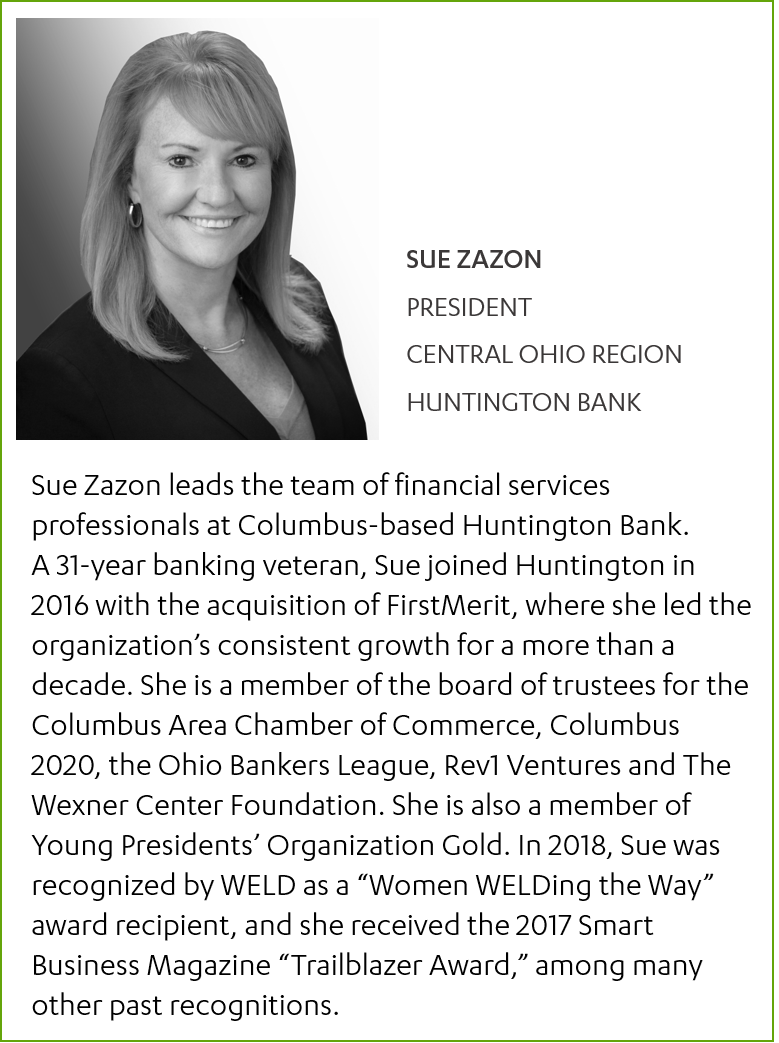Visionaries
We left our last interview with Andy Weeks from VanTrust Real Estate looking into the effects that rising costs are having on development and construction. We wanted to dive deeper into this trend and see how it affected real estate and construction from a lender’s perspective so we sat down with Sue Zazon, president of the central Ohio region for Huntington Bank, to gain a better understanding of the current state of affairs and maybe even understand a little better where these trends are heading.
Q: In a previous interview, we asked where Andy thought we were in the current business cycle. I would pose the same question to you: Where do you think we are in the current business cycle?
The economic expansion is now tied for the longest economic expansion on record at 120 months. The expansion is likely to continue given solid overall fundamentals, although some risks have risen in the last year. The official unemployment rate is an eye-popping 3.6% - its lowest in half a century! In addition to strong labor markets, consumers and businesses have solid financial conditions overall. Drifting below 2%, inflation has been remarkably low in the last year. This allows the Federal Reserve the flexibility to ease monetary policy should the economy need additional stimulus for growth. The fundamentals are generally solid, but some risks have arisen in the last year. The international economy has slowed this year, and uncertainties have increased regarding international trade policies. Parts of the economy such as agriculture have already been negatively impacted by trade disputes. The rate of growth in manufacturing has slowed this year, although non-manufacturing areas of the economy have retained solid economic growth in line with previous years. The economic expansion will likely continue even with increased downside risks, but the ultimate resolution of international trade concerns could increase the expansion’s strength and momentum.
Q: That leads to this follow up: What kind of effects, besides the cost of capital, do rate increases have on how you view commercial real estate lending now?
Whereas interest rates were generally rising in 2018, long-term interest rates have generally declined year-to-date in 2019. In addition, whereas the Federal Reserve raised the Fed funds rate target 4 times for a total of 1.0% in 2018, the expectation is that the Fed Funds rate target will decrease somewhat this year, bringing down the Prime commercial bank lending rate and other short-term interest rates, as well. Reductions in interest rates reduce the cost of borrowing, thereby increasing the demand for commercial real estate and construction. Hence, lower interest rates could provide a boost to commercial real estate and construction activity in 2019.
Q: Along the lines of policy, let's talk about government interference/regulation. How is regulation currently affecting your business?
I'm not sure we have enough time for me to thoroughly answer that question, so I'll just hit the high notes. The recent changes to Dodd-Frank have mostly benefited companies like Huntington. Basically, what they have done is widened the middle bracket of banks. Before, we were lumped in the same regulatory bucket as the big banks (Chase, Bank of America, Citi) that have trillions of dollars in assets. It made things difficult for us as a $105 billion asset bank, having to follow the same rules as institutions 10 times our size. When regulators moved the mark to $250 billion, it allowed us more flexibility to make decisions that impact our region, partners and business.
Q: So, overall, would you say your view of regulation is positive or negative?
Recent regulatory changes have been positive. I think it has created a more responsible and collaborative atmosphere among banking institutions that puts us on a more level and responsible playing field. That being said, there are still challenges. The mere fact that regulations change frequently and there is no precedent for how new regulations are interpreted can be challenging. Not knowing exactly how a regulation is going to be interpreted and applied can affect the cost of capital for real estate. Regulations are intended to be black and white, but interpretation is subjective. Regulators are people with perspectives and so are bankers, and therefore, there can be differences in interpretation. This makes it important for Huntington to have a collaborative relationship with regulators and with our peers so we can all work through the unknowns and try to create a business environment where there is as much clarity as possible.
Q: So, shining this light back toward commercial real estate, how does Huntington currently view it in terms of asset class?
At Huntington, our commercial real-estate portfolio is a sustaining and desirable segment of our asset base. We rely on it heavily for our business, and we do that with a very disciplined approach. Right now, we are not aggressively growing our portfolio, and we are committed to having room on our balance sheet to manage our current client’s needs. The commercial real estate portfolio has so much churn - construction loans perm out, assets change hands, etc. We are constantly monitoring it. The truth is we look at partnerships and relationships more than dollars when considering commercial real estate loans. In a frothy market like today, that may not make us the most aggressive lender, but we can look our partners in the eye and promise that we will be consistent, we will be disciplined, and we will be there for them in good times and when times are tougher.
Q: That is such a novel concept: to be relationship focused in a transactional world. How do you feel that creates value?
We thrive on being your partner. When there is an opportunity, or a problem (sometimes both together), we want to be the bank that will sit knee-to-knee with you and work through a solution that is beneficial for everyone involved. We say every day that we strive to make lives better, to make businesses thrive, and to make the communities we serve stronger. It is our Purpose for Being. Part of "walking the walk" in that respect is being there when we are needed. Some of the work going on in Franklinton is a good example. If we were a lender that only looked at pro-formas and proven areas of development, we would probably would not be involved as extensively in that area as we are. We have clients investing, and it is making the community we all live in better. We knew we wanted to be involved. It's literally our Purpose for Being.
After conducting this interview, I walked away feeling this renewed sense of excitement for the state of business today and in the future. Despite cost increases and the increasingly high cost of capital, Sue and Huntington Bank have demonstrated such a clear vision that, while the fundamentals and financials of a deal are important, there is still room in the weighing of opportunities for good old-fashioned partnership and serving the community. While excited about the partnership, I must say I was a little bit perplexed. My interview with this local business leader whose feelings about government intervention and regulation were, at worst, agnostic, but probably more accurately positive, surprised me. In our next installment, we will investigate the role that city and local government currently play in new construction and development.





